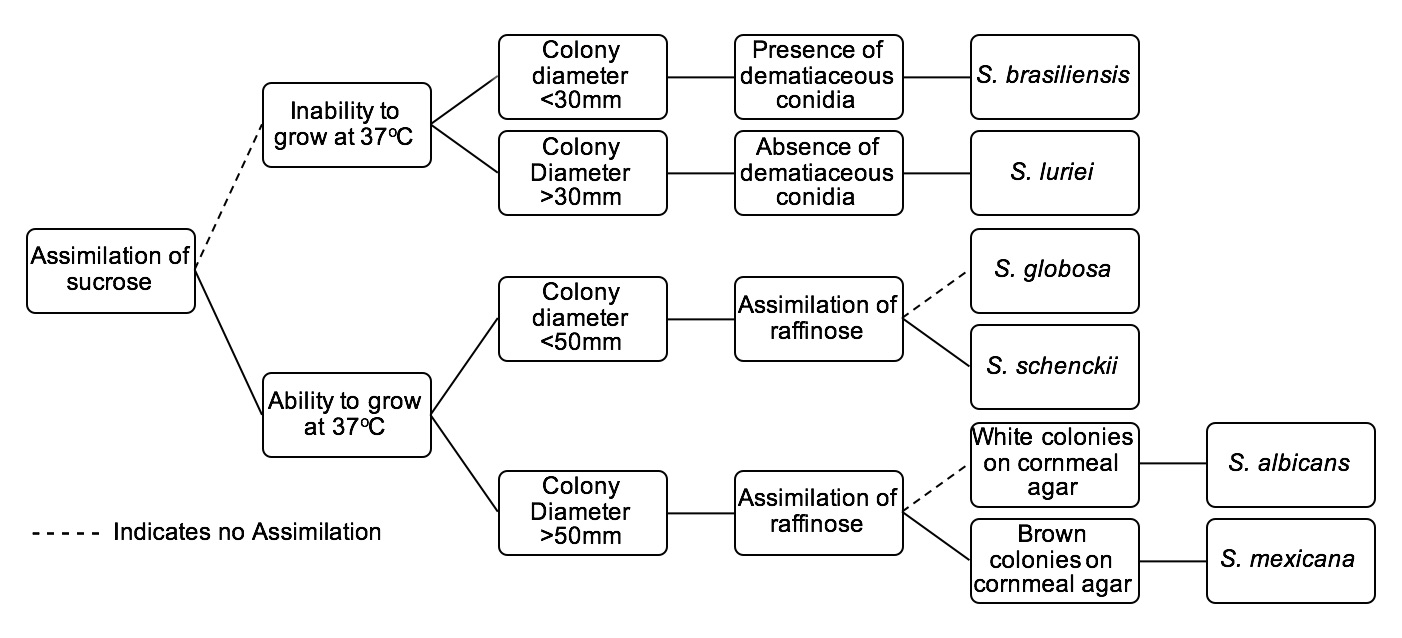Sporotrichosis laboratory findings: Difference between revisions
Jump to navigation
Jump to search
| Line 11: | Line 11: | ||
* Ultimately, the isolation of ''S. schenckii'' is dependent on 5-7 day a subculture of the fungus on enriched agars, such as Brain Heart Infusion agar, at 35-37ºC. Isolation is verified following the demonstration of dimorphism.<ref name="pmid21976602">{{cite journal| author=Barros MB, de Almeida Paes R, Schubach AO| title=Sporothrix schenckii and Sporotrichosis. | journal=Clin Microbiol Rev | year= 2011 | volume= 24 | issue= 4 | pages= 633-54 | pmid=21976602 | doi=10.1128/CMR.00007-11 | pmc=PMC3194828 | url=http://www.ncbi.nlm.nih.gov/entrez/eutils/elink.fcgi?dbfrom=pubmed&tool=sumsearch.org/cite&retmode=ref&cmd=prlinks&id=21976602 }} </ref> | * Ultimately, the isolation of ''S. schenckii'' is dependent on 5-7 day a subculture of the fungus on enriched agars, such as Brain Heart Infusion agar, at 35-37ºC. Isolation is verified following the demonstration of dimorphism.<ref name="pmid21976602">{{cite journal| author=Barros MB, de Almeida Paes R, Schubach AO| title=Sporothrix schenckii and Sporotrichosis. | journal=Clin Microbiol Rev | year= 2011 | volume= 24 | issue= 4 | pages= 633-54 | pmid=21976602 | doi=10.1128/CMR.00007-11 | pmc=PMC3194828 | url=http://www.ncbi.nlm.nih.gov/entrez/eutils/elink.fcgi?dbfrom=pubmed&tool=sumsearch.org/cite&retmode=ref&cmd=prlinks&id=21976602 }} </ref> | ||
* In some cases, isolation requires multiple subcultures. | * In some cases, isolation requires multiple subcultures. | ||
* While positive a culture is the strongest indication for diagnosis, this method may be more realistic in cutaneous forms of the disease than in certain systematic manifestations, due to greater lengths required for the collection of fungus in systematic forms.<ref name="pmid21976602" /> | |||
* Sporotrichosis is a [[chronic (medicine)|chronic]] disease with slow progression and often subtle symptoms. It is difficult to diagnose, as many other diseases share similar symptoms and therefore must be ruled out. | * Sporotrichosis is a [[chronic (medicine)|chronic]] disease with slow progression and often subtle symptoms. It is difficult to diagnose, as many other diseases share similar symptoms and therefore must be ruled out. | ||
* While within human and animal tissues, ''S. schenckii'' exists in its yeast form. | * While within human and animal tissues, ''S. schenckii'' exists in its yeast form. | ||
Revision as of 15:31, 25 January 2016
|
Sporotrichosis Microchapters |
|
Diagnosis |
|---|
|
Treatment |
|
Case Studies |
|
Sporotrichosis laboratory findings On the Web |
|
American Roentgen Ray Society Images of Sporotrichosis laboratory findings |
|
Risk calculators and risk factors for Sporotrichosis laboratory findings |
Editor-In-Chief: C. Michael Gibson, M.S., M.D. [1]; Associate Editor(s)-in-Chief: Alison Leibowitz [2]
Laboratory findings
- Definitive diagnosis of Sporotrichosis occurs upon the isolation and identification of S. schenckii in culture.
- The etiological agent may be obtained when the specimen is cultured on Sabouraud agar with chloramphenicol or on mycobiotic agar.[1]
- Filamentous hyaline colonies begin to grow following 5-7 days of incubation at 25ºC, and may manifest with pigmented centers.[2]
- Ultimately, the isolation of S. schenckii is dependent on 5-7 day a subculture of the fungus on enriched agars, such as Brain Heart Infusion agar, at 35-37ºC. Isolation is verified following the demonstration of dimorphism.[3]
- In some cases, isolation requires multiple subcultures.
- While positive a culture is the strongest indication for diagnosis, this method may be more realistic in cutaneous forms of the disease than in certain systematic manifestations, due to greater lengths required for the collection of fungus in systematic forms.[3]
- Sporotrichosis is a chronic disease with slow progression and often subtle symptoms. It is difficult to diagnose, as many other diseases share similar symptoms and therefore must be ruled out.
- While within human and animal tissues, S. schenckii exists in its yeast form.
- Varying in size and shape, these curved cells typically have 2-6 μm diameters with cigar-like buds offshooting from a narrow base.
- Growing on Sabouraud dextrose agar, most S. schenckii strains become evident after 4 days. At this point, some strains lack dark pigment, while others have been infiltrated with dark pigment from the start. Upon transfer to Brain-Heart Infusion (BHI) agar, and cultured for 7 days at 37°C, the S. schenckii strains undergo dimorphism, manifesting as creamy off-white to beige colored colonies.[3]
- Patients with sporotrichosis will likely have antibodies against the fungus S. schenckii, however, due to variability in sensitivity and specificity, antibody identification may not be a reliable diagnosis for this disease. The confirming diagnosis remains culturing the fungus from the skin, sputum, synovial fluid, and cerebrospinal fluid.
- Cats with sporotrichosis are unique in that the exudate from their lesions may contain numerous organisms. This makes cytological evaluation of exudate a valuable diagnostic tool in this species. Exudate is pyogranulomatous and phagocytic cells may be packed with yeast forms. These are variable in size, but many are cigar-shaped.[4]
Culture and Identification
The gold standard for diagnosis of Sporotrichosis is with fungal culture. The tree below serves as an identification key for six Sporothrix species of clinical interest:

References
- ↑ Oliveira DC, Lopes PG, Spader TB, Mahl CD, Tronco-Alves GR, Lara VM; et al. (2011). "Antifungal susceptibilities of Sporothrix albicans, S. brasiliensis, and S. luriei of the S. schenckii complex identified in Brazil". J Clin Microbiol. 49 (8): 3047–9. doi:10.1128/JCM.00255-11. PMC 3147739. PMID 21653757.
- ↑ Morris-Jones R (2002). "Sporotrichosis". Clin Exp Dermatol. 27 (6): 427–31. PMID 12372075.
- ↑ 3.0 3.1 3.2 3.3 Barros MB, de Almeida Paes R, Schubach AO (2011). "Sporothrix schenckii and Sporotrichosis". Clin Microbiol Rev. 24 (4): 633–54. doi:10.1128/CMR.00007-11. PMC 3194828. PMID 21976602.
- ↑ Alvarado-Ramírez E, Torres-Rodríguez JM (2007). "In vitro susceptibility of Sporothrix schenckii to six antifungal agents determined using three different methods". Antimicrob Agents Chemother. 51 (7): 2420–3. doi:10.1128/AAC.01176-06. PMC 1913275. PMID 17438048.